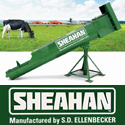 |
 |

|
|
|
New York Ag News Headlines |
 |
Experts Address Livestock Production, Climate, Natural Resources
New York Ag Connection - 09/16/2019
When conversations turn to the world's climate and natural resources they often also go to livestock production. And that's the idea behind a session at the Global Agenda for Sustainable Livestock international meeting hosted by Kansas State University this
past week.
The topic, Climate and Natural Resource Use was one of several addressed as GASL delegates from around the world convened to talk about opportunities and challenges for livestock producers in countries large and small.
A growing number of countries have identified livestock as an important topic in larger climate discussions including the role of methane, said Henning Steinfeld, with the United Nation's Food and Agriculture Organization. He noted that from smallholder farms,
with just a few head of livestock, to intensive cattle feedlots with thousands of cattle, there's a huge diversity with what resources are used.
Part of the discussion, Steinfeld said, should also be that many grasslands are healthier if they're grazed and that domestic animals play a role. Also, pastures can act as a carbon sink.
There's a growing move toward intensive livestock production, he said, which offers greater efficiency but among the challenges with that is a reliance on soy as a feed ingredient. Some producers are looking for alternative feeds.
Considerations in livestock production are its contribution to the food supply and food security with an eye toward the environmental impacts.
The Climate and Natural Resource Use session was designed for delegates to hear different viewpoints, including innovations in livestock production.
Steinfeld said some of the innovations being explored are better efficiency in decreasing methane emission intensity; better use of nutrients, water and energy -- "a nice synergy" -- and the use of animal waste.
Ian McConnell with the World Wildlife Fund International, offered a response. The WWF produces the "Living Planet Report" which he said shows the state of the planet is declining and that food production and particularly livestock are a large part of that
decline.
There's a need to initially stop the decline of the climate, he said, noting that most of meat globally is produced in intensive systems, so that while there are gains in nutrition, there has been a net environmental loss. He encouraged delegates to "take ownership" of
the challenges in livestock production and take the lead in coming up with solutions.
"We have a large land footprint but it's not always a degradation of land," he said. "We need to redefine what our footprints are. We won't solve it right away." He added that waiting to be proactive could make the livestock sector vulnerable.
In an "Innovation in Action" segment, Tom Jones with Hy-Plains Feedyard in Montezuma, Kan., gave examples of how an intensive operation with a capacity of 50,000 cattle is addressing environmental challenges.
Hy-Plains has sharpened focus on water conservation in the last four years, including limited irrigation in its cropping systems. Through genetic selection it's also choosing cattle that use feed more efficiently.
Though corn is a primary ingredient in livestock feed, its requirements for water have Hy-Plains considering other feed ingredients such as sorghum that requires less water but is different nutritionally.
Jones said the feedyard is changing traditional cattle feeding strategies by:
- Communicating with producers about vaccination prior to when they enter the feedlot in order to reduce pharmaceuticals through the animal's life.
- Sorting and managing animals to target optimal finish time and end product specifications.
- Use genetics to produce cattle that achieve the quality grade choice or higher.
- Optimize land use to grow cattle heavier and more cost effective prior to arriving at feedyard.
Hy-Plains is also actively promoting soil health and has made gains toward becoming carbon neutral, Jones said, by improving soil health through using crop rotations, cover crops and other practices. "I think it's doable in Kansas," he said.
In another "Innovation in Action" presentation by Walter Oyhantcabal with the Ministry of Livestock Agriculture and Fisheries in Uruguay, Oyhantcabal said Uruguay's economy is largely based on livestock and that most cattle are grass-fed.
Uruguay's government has implemented mandatory traceability of cattle, growth promotants are prohibited by law, and there is no change in land use (no deforestation). However, almost 75% of greenhouse gas emissions come from agriculture, mostly livestock.
Government policies have set three targets: More food and fiber, less environmental footprint and mitigation of and adaptation to climate change. To achieve those, the country established a new paradigm to guide changes in the livestock sector to support
economic, social, welfare, biodiversity, soil fertility, and the ecosystem. He cited grazing management as one area of focus.
Uruguay is the first developing country to set mitigation targets in terms of emissions intensity in the beef sector, with goals of 33% less methane by 2030 unconditionally, compared with 1990, and 31% less nitrous oxide.
An additional perspective was provided by Mario Herroro, with the Commonwealth Scientific and Industrial Research Organisation and University of Queensland who said, "We are reaching a global convergence on the need for more sustainable food
production systems." He cited a recent Lancet report on make fruits and vegetables the primary star of the plate.
What's feasible now, Herroro said, is disruptive innovation, some of which could be applied to the livestock sector, such as using plant substitutes, new feeds, algae, and microbial protein from sewage and waste as animal feed and among others possibilities.
"It will be expensive at the beginning, but the prices will come down," Herroro said.
|
 |


|
 |
|
Copyright © 2024 - Farms.com. All Rights Reserved. |
 |
|